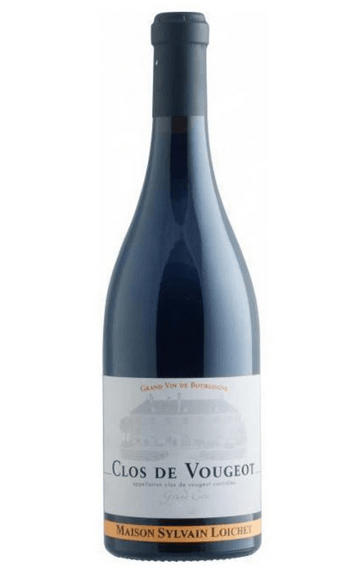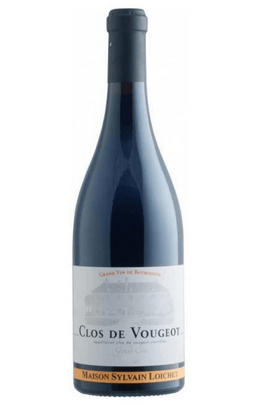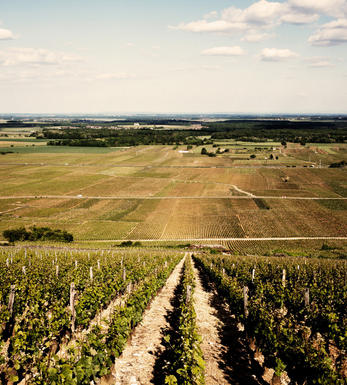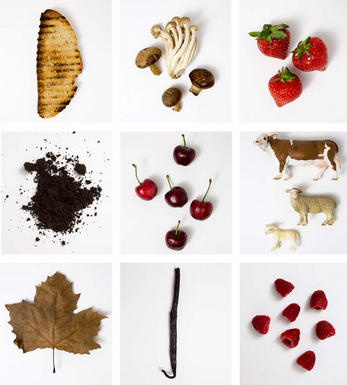
2010 Clos de Vougeot, Grand Cru, Sylvain Loichet, Burgundy

About this WINE

Sylvain Loichet
The Loichets come from Comblanchien (southern end of Cote de Nuits), as well known for its marble quarrying industry as for its vines. Indeed the previous two generations of Loichets have been stone masons rather than vignerons but they kept ownership of their vineyards (Cote de Nuits Villages, Clos de Vougeot and Ladoix blanc) which the talented Sylvain (early 20s) has taken back.
Since he does not own enough vines to make a really decent living, he has added some well chosen negociant cuvees (mostly white) which are equally impressive. The white wines are made with a great sense of precision and are full of energy. The reds are vigorous, full of fruit and look set to age very well.

Vougeot
Most of the wine produced in this small village comes from a single, walled Grand Cru vineyard, the famous Clos de Vougeot. The vineyard in its present form dates from 1336 (when it was first planted by monks of Cîteaux), although it was not until the following century that it was entirely enclosed by stone walls.
Clos de Vougeot is both the smallest commune and the largest Clos in the Cote d’Or. It consists of 50 hectares of vineyards shared among 82 owners, with six soil types. There is quite a difference in quality between the upper (best) and lower (least fine) parts of the vineyard, though in medieval times a blend from all sectors was considered optimum.Le Domaine de la Vougeraie makes a very fine white wine from Le Clos Blanc de Vougeot, first picked out by the monks of Cîteaux as being suitable ground for white grapes in the year 1110.
- Five hectares of village Vougeot
- 12 hectares of Premier Cru vineyards (four in all): Les Cras, Les Petits-Vougeots, Clos de la Perrière and Clos Blanc de Vougeot
- 51 hectares of Grand Cru vineyard – Clos de Vougeot
- Recommended producers: Domaine de la Vougeraie, Domaine Bertagna, Engel, Anne Gros, Grivot, Liger-Belair, Meo-Camuzet.

Pinot Noir
Pinot Noir is probably the most frustrating, and at times infuriating, wine grape in the world. However when it is successful, it can produce some of the most sublime wines known to man. This thin-skinned grape which grows in small, tight bunches performs well on well-drained, deepish limestone based subsoils as are found on Burgundy's Côte d'Or.
Pinot Noir is more susceptible than other varieties to over cropping - concentration and varietal character disappear rapidly if yields are excessive and yields as little as 25hl/ha are the norm for some climats of the Côte d`Or.
Because of the thinness of the skins, Pinot Noir wines are lighter in colour, body and tannins. However the best wines have grip, complexity and an intensity of fruit seldom found in wine from other grapes. Young Pinot Noir can smell almost sweet, redolent with freshly crushed raspberries, cherries and redcurrants. When mature, the best wines develop a sensuous, silky mouth feel with the fruit flavours deepening and gamey "sous-bois" nuances emerging.
The best examples are still found in Burgundy, although Pinot Noir`s key role in Champagne should not be forgotten. It is grown throughout the world with notable success in the Carneros and Russian River Valley districts of California, and the Martinborough and Central Otago regions of New Zealand.


Buying options
Add to wishlist
Description
There is a touch of reduction on the backward nose of this Clos de Vougeot which is currently very tightly knit and in need of further élévage. The structure is in place though and the finish is persistent enough to suggest that the wine has fine potential.
Jasper Morris MW, Burgundy Director
This is a thoroughly fine range from the young and enthusiastic Sylvain Loichet in 2010. The whites have their usual energy and pure fruit while the reds have been fine-tuned, with a slightly shorter time in vat producing far more elegant wines. This is becoming an exceptionally good address. Note also the two cuvées of Corton-Charlemagne from different parts of the hill.
Sylvain’s parcel of vines is over seventy years old and is situated in the south of the Clos, towards Voosne-Romanée, around halfway up the vineyard on deep clay soils with a well-drained, stony topsoil. From the excellent 2010 vintage, this wine is now really coming into its stride, unfurling majestically from its slumber to reveal beguiling aromas of black and red berry fruits. The previously tightly-wound palate has opened up beautifully to reveal a silky tannic structure backed up by the genuine power of a Grand Cru. Drinking beautifully now, but will continue to improve for several years.
wine at a glance
Delivery and quality guarantee